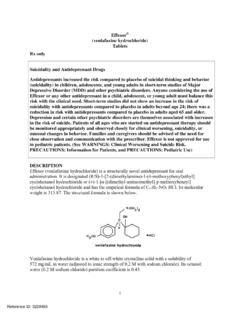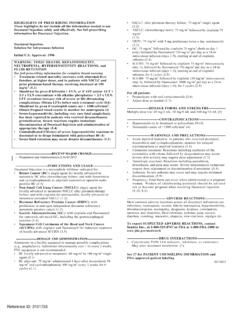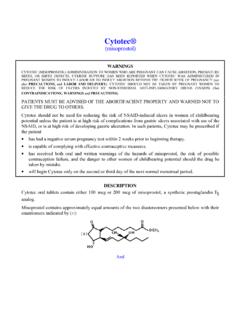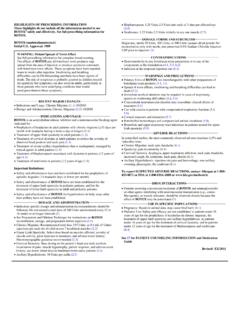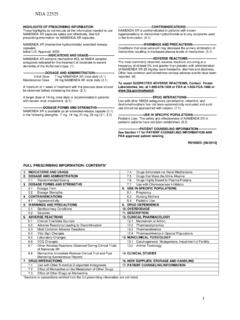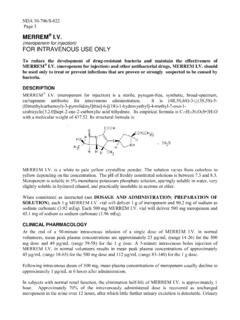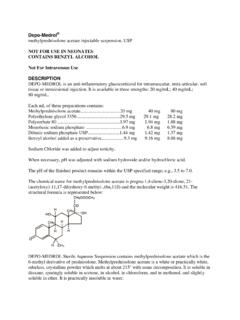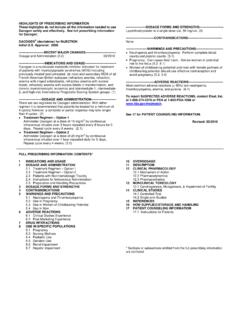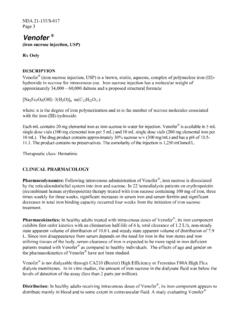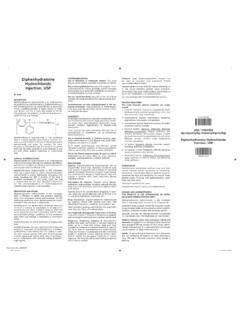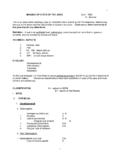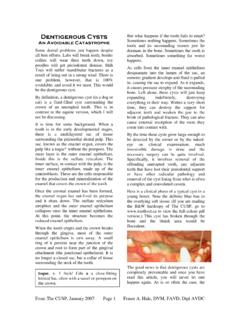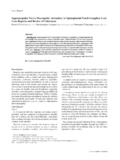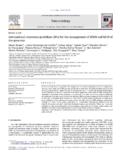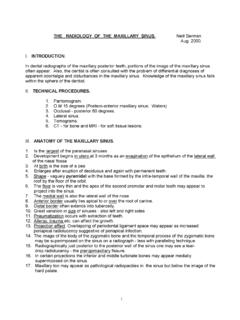Transcription of CYST:RX2P CYSTAGON (cysteamine bitartrate) Capsules 50 …
1 NDA 20-392/S-010 Page 3 CYST:RX2P CYSTAGON ( cysteamine bitartrate ) Capsules 50 mg and 150 mg Rx only DESCRIPTION: CYSTAGON ( cysteamine bitartrate ) Capsules for oral administration, contain cysteamine bitartrate , a cystine depleting agent which lowers the cystine content of cells in patients with cystinosis, an inherited defect of lysosomal transport. CYSTAGON is the bitartrate salt of cysteamine , an aminothiol, beta-mercaptoethylamine. cysteamine bitartrate is a highly water soluble white powder with a molecular weight of 227 and the molecular formula C2H7NS C4H6O6.
2 It has the following chemical structure: NH2CH2 HOCCHOCHOCOHSHCH2 OHOH Each CYSTAGON capsule contains 50 mg or 150 mg of cysteamine free base as cysteamine bitartrate . CYSTAGON Capsules contain the following inactive ingredients: colloidal silicon dioxide, croscarmellose sodium, D&C yellow no. 10 aluminum lake, FD&C blue no. 1 aluminum lake, FD&C blue no. 2 aluminum lake, FD&C red no. 40 aluminum lake, gelatin, magnesium stearate, microcrystalline cellulose, pharmaceutical glaze, pregelatinized starch, silicon dioxide, sodium lauryl sulfate, synthetic black iron oxide and titanium dioxide.
3 CLINICAL PHARMACOLOGY: Mechanism of Action: Cystinosis is an autosomal recessive inborn error of metabolism in which the transport of cystine out of lysosomes is abnormal; in the nephropathic form, accumulation of cystine and formation of crystals damage various organs, especially the kidney, leading to renal tubular Fanconi Syndrome and progressive glomerular failure, with end stage renal failure by the end of the first decade of life. In four studies of cystinosis patients before cysteamine was available, renal death (need for transplant or dialysis) occurred at median age of less than 10 years.
4 Patients with cystinosis also experience growth failure, rickets, and photophobia due to cystine deposits in the cornea. With time most organs are damaged, including the retina, muscles and central nervous system. cysteamine is an aminothiol that participates within lysosomes in a thiol-disulfide interchange reaction converting cystine into cysteine and cysteine- cysteamine mixed disulfide, both of which can exit the lysosome in patients with cystinosis. NDA 20-392/S-010 Page 4 Pharmacokinetics and Pharmacodynamics: Normal individuals and persons heterozygous for cystinosis have white cell cystine levels of < and usually below 1 nmol/1 2 cystine/mg protein, respectively.
5 Individuals with nephropathic cystinosis have elevations of white cell cystine above 2 nmol/1 2 cystine/mg protein. White cell cystine is monitored in these patients to determine adequacy of dosing, levels being measured 5 to 6 hours after dosing. In the Long-Term Study (see Clinical Trials, below) entry white cell cystine levels were nmol/1 2 cystine/mg protein (range to nmol/1 2 cystine/mg protein) and were maintained close to 1 nmol/1 2 cystine/mg protein with a cysteamine dose range of to g/m2/day.
6 After administration of cysteamine HCl, leukocyte cystine levels fall, with minimum levels at approximately 1 hour. Because cysteamine HCl has an unpleasant taste and odor, other formulations have been developed, including phosphocysteamine, the phosphorothioester of cysteamine that is rapidly converted to cysteamine in the gut, and cysteamine bitartrate ( CYSTAGON ). cysteamine bitartrate has been shown in a transfer study in 8 patients to maintain white cell cystine levels below 1 nmol/1 2 cystine/mg protein when substituted for cysteamine HCl or phosphocysteamine.
7 Total cysteamine levels 2 and 6 hours post-dosing were higher after cysteamine bitartrate than for the solutions. The pharmacokinetics and pharmacodynamics of CYSTAGON were studied in eleven pediatric patients with nephropathic cystinosis who received 225 to 550 mg of cysteamine bitartrate every 6 hours daily for more than one year. Following repeated oral administration of 225 to 550 mg cysteamine bitartrate , the mean time to maximum plasma concentration (Tmax) occurred at about hours post dose with mean steady-state peak plasma concentration (Cmax) and area under the concentration-time curve (AUC) of g/mL and g hr/mL, respectively.
8 The apparent volume of distribution and apparent plasma clearance of cysteamine were 156 L and L/min, respectively. cysteamine was moderately bound to human plasma proteins, predominantly to albumin, with mean protein binding of about 52%. Plasma protein binding was independent of concentration over the concentration range achieved clinically with the recommended doses. The pharmacodynamic response increased with the plasma cysteamine concentration, with maximum response occurring approximately hours post dose with an average reduction of white cell cystine concentration of about nmol/1 2 cystine/mg protein and returning to baseline level 6 hours post dose.
9 The mean white cell cystine concentration and mean cysteamine plasma concentration-time profile is shown below: NDA 20-392/S-010 Page 5 Most clinical data have been developed using cysteamine HCl or phosphocysteamine solutions. In all discussions that follow, administered amounts of various cysteamine salts will be expressed as amounts of cysteamine free base. Clinical Studies: There are approximately 200 pre-transplant cystinosis patients in the United States with nephropathic cystinosis and clinical studies have included almost all of them, in addition to about 40 studied in the United Kingdom.
10 For all patients, mean age at entry into studies was just under 4 years. Patients were approximately equally divided between genders and about 85% were white, 9% were black, and 3% were hispanic. The National Collaborative cysteamine Study (NCCS) treated 94 children (mainly from the United States) with nephropathic cystinosis with increasing doses of cysteamine HCl (mean dose 54 mg/kg/day) to attain white cell cystine levels of less than 2 nmol/1 2 cystine/mg protein 5 to 6 hours post-dose, and compared their outcome with an historical control group of 17 children who had been in the placebo group of a randomized placebo-controlled trial of ascorbic acid.
